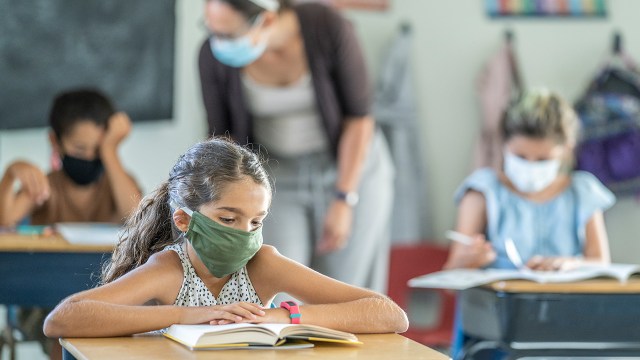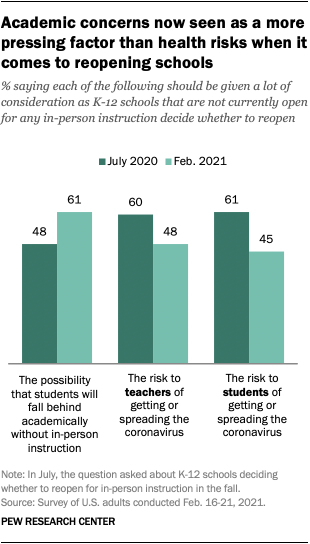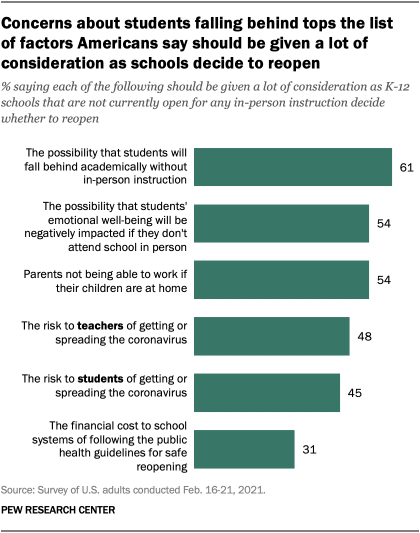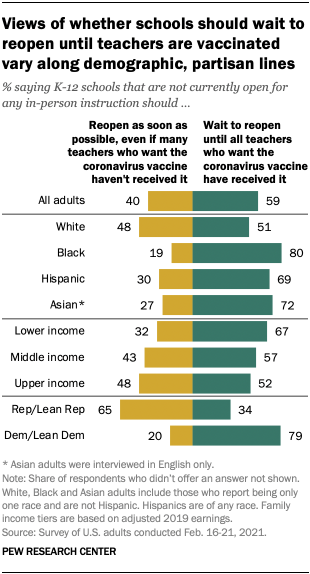
Amid new guidance from the Centers for Disease Control and Prevention (CDC) on how to safely reopen K-12 schools for in-person instruction, Americans are increasingly concerned about the effect of virtual learning on academic progress.
To explore Americans’ views about the factors that should be considered in reopening K-12 schools as well as the timing, we surveyed 10,121 U.S. adults from Feb. 16-21, 2021. Everyone who took part is a member of Pew Research Center’s American Trends Panel (ATP), an online survey panel that is recruited through national, random sampling of residential addresses. This way, nearly all U.S. adults have a chance of selection. The survey is weighted to be representative of the U.S. adult population by gender, race, ethnicity, partisan affiliation, education and other categories. Read more about the ATP’s methodology. Here are the questions used for this analysis, along with responses, and its methodology.
Compared with last summer, a higher share of U.S. adults now say the possibility that students will fall behind academically without in-person instruction should be given a lot of consideration as schools decide whether to reopen. And smaller shares now say the health risk to teachers or students should be given a lot of consideration, according to a new Pew Research Center survey.
At the same time, a majority of U.S. adults (59%) say K-12 schools that are not currently open for in-person instruction should wait to reopen until all teachers who want the coronavirus vaccine have received it. By comparison, 40% say these schools should reopen as soon as possible, even if many teachers who want the vaccine haven’t received it.
Views about the factors that should be considered in reopening schools as well as the timing don’t vary significantly between those who have children enrolled in elementary, middle or high school and those who don’t.
About six-in-ten Americans (61%) now say K-12 schools that are not currently open for any in-person instruction should give a lot of consideration to the possibility that students will fall behind academically when deciding whether to reopen. In July 2020, 48% said this should be given a lot of consideration as schools made decisions about whether to open for in-person instruction in the fall. The shares saying schools should give a lot of consideration to the risk to teachers (48%) or students (45%) of getting or spreading the coronavirus are both down from about six-in-ten who said in July that each should be a major factor in decisions about reopening.
The changes have been more modest in the shares saying a lot of consideration should be given to parents not being able to work if their children are home (up from 49% in July to 54% today) and to the financial costs to school systems of following public health guidelines for safe reopening (down from 34% to 31%).
More than half (54%) point to the possibility that students’ emotional well-being will be negatively impacted if they don’t attend school in person as a factor that should be given a lot of consideration in decisions about reopening (this item was not asked in the July 2020 survey). Although the importance of each factor asked about in the survey varies, three-quarters or more say each of them should be given at least some consideration.
Views vary by racial and ethnic groups and along party lines
As was the case last summer, Black, Hispanic and Asian adults are more likely than White adults to say that the risks to teachers and students of getting or spreading the coronavirus should be given a lot of consideration in deciding whether to reopen schools for in-person instruction. Black adults are particularly likely to say these health risks should be a major factor. And lower-income adults remain more likely than those with middle or upper incomes to say the same, as do Democrats compared with Republicans (including those who lean to each party).
When it comes to the possibility that students will fall behind academically without in-person instruction, majorities of White (65%) and Hispanic (60%) adults say this should be given a lot of consideration in deciding whether to reopen schools, while a smaller share of Black adults (49%) say the same. White adults (58%) are also more likely than Black adults (44%) to say the possibility that students’ emotional well-being will be negatively impacted if they don’t attend school in person should be a major factor; 53% of Hispanic adults say this. (Because these items were asked of a random half of the sample, the number of Asian American respondents is too small to analyze separately.)
Republicans are far more likely than Democrats to point to concerns about students’ academic progress and emotional well-being as factors that should be given a lot of consideration in decisions about reopening schools. A majority of Republicans and those who lean Republican say this about the possibility of students falling behind academically (76% vs. 51% of Democrats and Democratic leaners) and a negative impact on students’ emotional well-being (65% vs. 46%).
Similar patterns are evident when it comes to the question of reopening K-12 schools for in-person instruction even if many teachers who want the coronavirus vaccine haven’t received it, or whether to wait until all teachers who want the vaccine have received it. Majorities of Black (80%), Hispanic (69%) and Asian (72%) adults say schools should wait to reopen until teachers have been vaccinated, compared with about half of White adults (51%). And while two-thirds of lower-income adults and 57% of those with middle incomes say schools should wait to reopen, upper-income adults are more divided (52% say schools should wait until all teachers receive the vaccine and 48% say schools should reopen as soon as possible).
Partisan differences are even more pronounced. About eight-in-ten Democrats (79%) think schools should wait to reopen until all teachers who want the coronavirus vaccine have received it. In contrast, about two-thirds of Republicans (65%) say schools should reopen as soon as possible, even if many teachers who want the vaccine haven’t received it.
Note: Here are the questions used for this analysis, along with responses, and its methodology.



